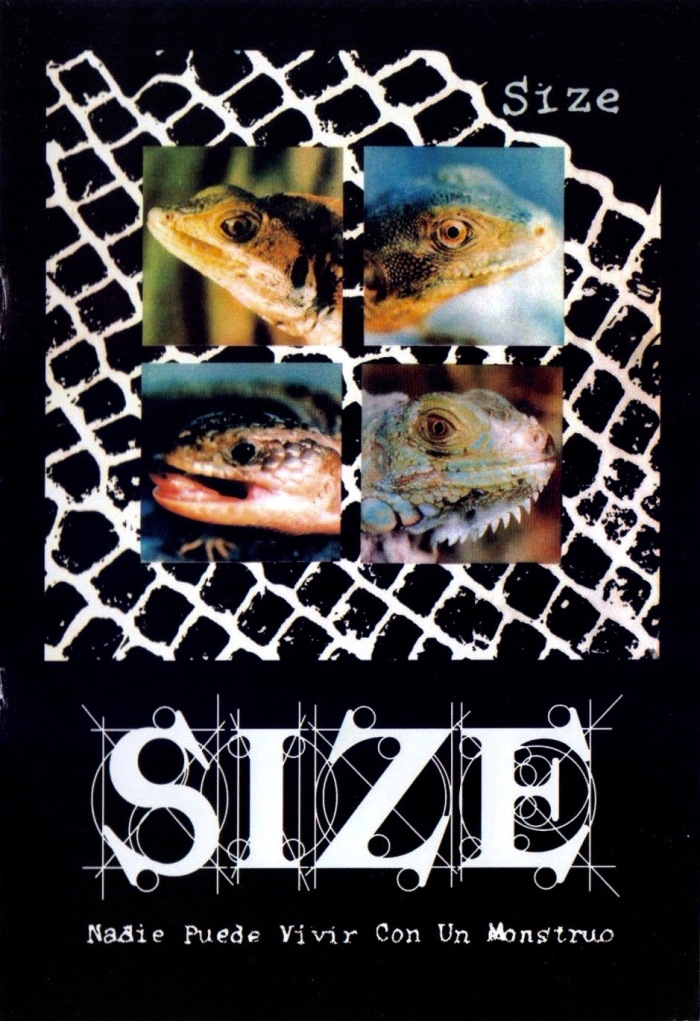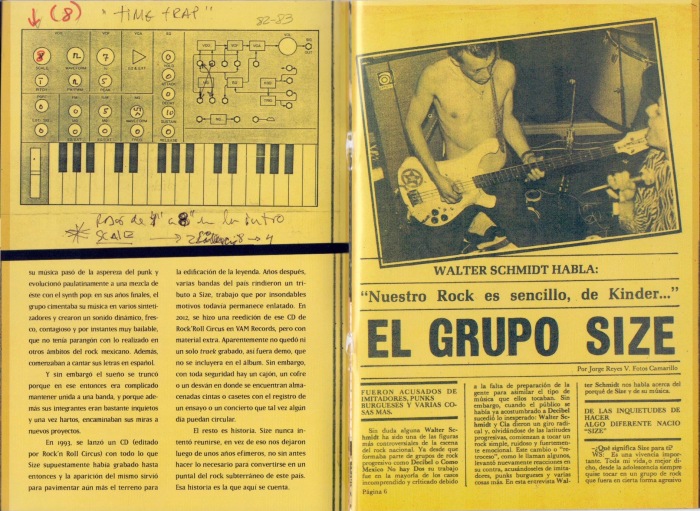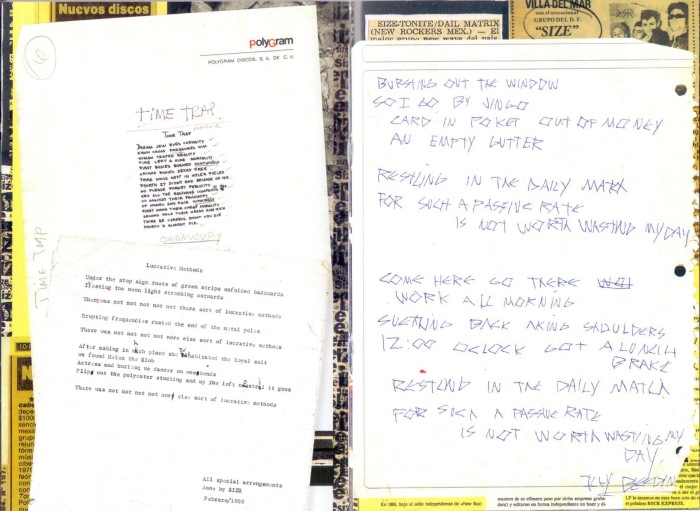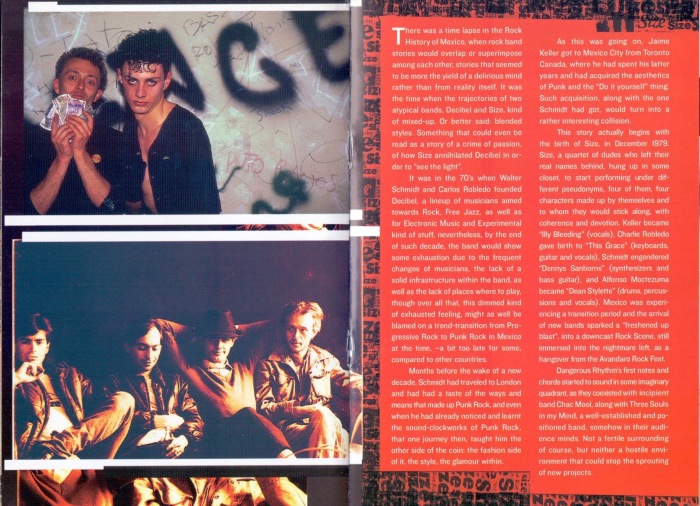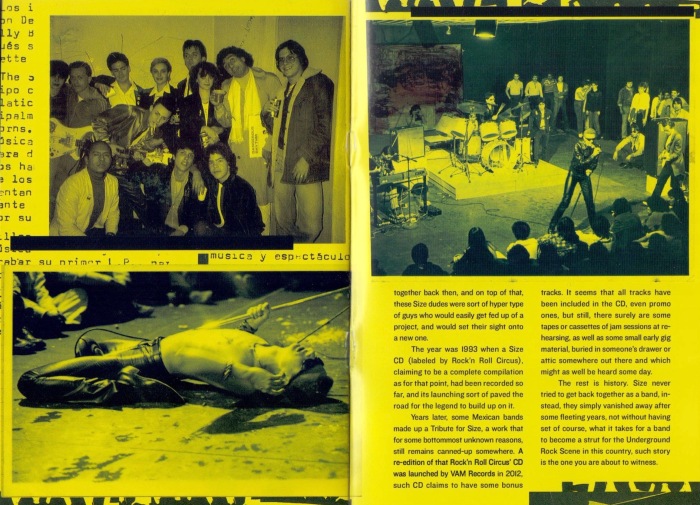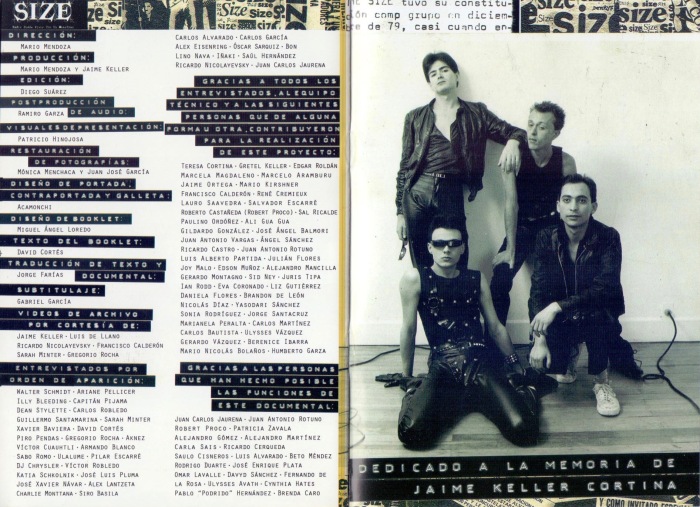Hubo un tiempo, en los anales del rock hecho en México, en donde las historias se empalmaban, entreveraban y parecían ser más el fruto de una mente delirante que resultado de la realidad. A ese lapso corresponde un momento en donde las trayectorias de Decibel y Size, dos bandas atípicas, se confunden. O mejor deberíamos decir: se funden. O también puede leerse como la historia de un crimen pasional, de cómo Size aniquiló a Decibel para ver la luz.
En la década de los setenta, Walter Schmidt y Carlos Robledo fundaron Decibel, una agrupación inclinada al rock, al free jazz, a la electrónica y a la experimentación; sin embargo, al llegar al final de la citada década, la agrupación daba muestras de agotamiento resultado de los cambios de alineación, la ausencia de una infraestructura sólida y lugares para tocar; pero sobre todo porque en ese instante, aunque tardío, en México se empezaba a sentir el viraje del rock progresivo hacia el punk.
Meses antes de entrar a un nuevo decenio, Schmidt había viajado a Londres y observado de primera mano las manifestaciones del punk; si bien ya antes había advertido las maquinaciones sonoras del movimiento, su viaje le mostró otra faceta, a la de la moda, el estilo, el glamour.
Jaime Keller, por su parte, llegó a México procedente de Toronto, Canadá, lugar donde había pasado los últimos años y había bebido directamente la estética del punk y del Do It Yourself. Esa mirada, junto con la de Schmidt, provocaría una interesante colisión.
Esta historia en realidad se inicia cuando en diciembre de 1979 nace oficialmente Size, cuarteto integrado por individuos que dejaron su nombre verdadero colgado en el perchero y actuaron bajo distintos seudónimos, bajo cuatro personajes que ellos mismos construyeron y a los que se apegaron con devoción y coherencia: Keller se transformó en Illy Bleeding (voz), Charlie Robledo alumbró a This Grace (teclados, guitarra, voz), Schmidt engendró a Dennys Sanborns (sintetizador, bajo) y Alfonso Moctezuma a Dean Stylette (batería, percusiones y voz). Se vive una transición y en México, el arribo de nuevas agrupaciones imprime bríos a una alicaída escena, todavía sumergida en las pesadillas generadas por la resaca del Festival de Avándaro.
Suenan en un cuadrante imaginario las primeras notas de Dangerous Rhythm y éstos conviven con un incipiente Chac Mool o un ya establecido, al menos en el inconsciente popular, Three Souls in My Mind. No es un entorno fértil, pero tampoco la aridez es tal que impida la germinación de nuevos proyectos.
Size nació como un grupo de punk, pero no un grupo de punk de la periferia del Distrito Federal que cantara con rabia acerca de la desigualdad o la injusticia; no, Size nació como varios de los grupos de punk de esos años: en el seno de la clase media. Lo suyo, más que nada, era una visión hedonista de la vida y en ella imperaba el estilo. Esos primeros años, crudos por la ausencia de una tecnología que permitiera moldear delicadamente los sonidos y marcados por la estética del DIY, una estética asumida más por la necesidad que por un seguimiento de las modas imperantes, muestran al cuarteto orientado hacia el punk y la nueva ola. A esta etapa pertenece la edición de un sencillo promocional (“Tonite”/ “Daily Matrix”, New Rockers, 1980), un corte (“She’s so”) editado en el triple Rock nacional 1981 (Prisma, 1981) y otra canción (“Go-Go Girl”) incluida en la compilación Sound Cosmodel (Skating Pears, 1984).
En sus inicios cantaban en inglés no por ir a contracorriente, sino por dos razones: hacerlo en ese idioma era prácticamente la norma en el rock hecho en México. Aunque ya había atisbos de dar forma a un rock cantado en castellano, éstos aún eran incipientes; la otra razón, a Illy, el letrista, le acomodaba mejor esa lengua.
Tocaban donde podían, básicamente en universidades, centros nocturnos, no sólo en el Distrito Federal, también lograron llegar a varias plazas del interior del país. Aparecían, cuando les era dable, en televisión; y también en las frecuencias radiofónicas, aunque su presencia en el dial no era una costumbre.
En 1984, apareció el single “El Diablo en el Cuerpo”/ “La Cabellera de Berenice”, disco de 12”, enfundado en una portada blanca con un hermoso logo trazado en letras negras y una momia en el centro. Dos canciones apenas, pero suficientes para alumbrar una leyenda.
Size grababa su primer álbum (de hecho lo completaron) cuando decidieron separarse. Entonces cómo, se preguntarán, una banda de vida fugaz, con apenas un par de canciones, pudo erigirse en un mito. Difícil comprenderlo en una época en donde Internet responde a todas las preguntas, pero no aporta mucho cuando de rock mexicano se trata. El cuarteto enarboló una bandera del estilo, de la elegancia; su música pasó de la aspereza del punk y evolucionó paulatinamente a una mezcla de éste con el synth pop: en sus años finales, el grupo cimentaba su música en varios sintetizadores y crearon un sonido dinámico, fresco, contagioso y por instantes muy bailable, que no tenía parangón con lo realizado en otros ámbitos del rock mexicano. Además, comenzaban a cantar sus letras en español.
Y sin embargó el sueño se truncó porque en ese entonces era complicado mantener unida a una banda, y porque además sus integrantes eran bastante inquietos y una vez hartos, encaminaban sus miras a nuevos proyectos.
En 1993, se lanzó un CD (editado por Rock’n Roll Circus) con todo lo que Size supuestamente había grabado hasta entonces y la aparición del mismo sirvió para pavimentar aún más el terreno para la edificación de la leyenda. Años después, varias bandas del país rindieron un tributo a Size, trabajo que por insondables motivos todavía permanece enlatado. En 2012, se hizo una reedición de ese CD de Rock’Roll Circus en VAM Records, pero con material extra. Aparentemente no quedó ni un solo track grabado, así fuera demo, que no se incluyera en el álbum. Sin embargo, con toda seguridad hay un cajón, un cofre o un desván en donde se encuentran almacenadas cintas o casetes con el registro de un ensayo o un concierto que tal vez algún día puedan circular.
El resto es historia. Size nunca intentó reunirse, en vez de eso nos dejaron luego de unos años efímeros, no sin antes hacer lo necesario para convertirse en un puntal del rock subterráneo de este país. Esa historia es la que aquí se cuenta.
-David Cortés
